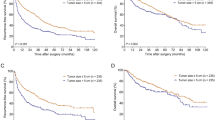Abstract
To observe the curative effect of surgery combined with gene therapy on small hepatocellular carcinoma. Seventy-seven patients with small hepatocellular carcinoma (diameter < 5 cm) underwent surgical resection. The tumor located at the edge of the liver was treated by local excision or irregular hepatectomy. The tumor in the center of the liver was resected by hepatic lobectomy in order to ensure at least a 2-cm safety margin. Fifty-four patients underwent gene therapy (gene group) one or two times before operation, whereas 23 patients underwent surgery alone (control group) selected by themselves. The injectable gene was made of ADV-TK (adenovirus containing thymidine kinase suicide gene, with a concentration of 5 × 1012/ml). The prognosis of patients was analyzed by imaging twice a year. In the gene group, the 1-, 3-, and 5-year survival rates were 91.4, 63.6, and 52.1%. In the control group, the survival rates were 84.3, 54.4, and 32.6%, respectively. There was a significant difference in the overall survival rates between two groups. Factors associated with overall survival in univariate analysis included bilirubin, prothrombin activity, cirrhosis, and gene therapy (P < 0.05). In the multivariate analysis, it included cirrhosis, gene therapy, and bilirubin. The gene therapy hepatocellular carcinoma patients with a diameter < 5 cm could significantly reduce recurrence after operation. It was worthy of being popularized.
This is a preview of subscription content, access via your institution
Access options
Subscribe to this journal
Receive 12 print issues and online access
$259.00 per year
only $21.58 per issue
Buy this article
- Purchase on Springer Link
- Instant access to full article PDF
Prices may be subject to local taxes which are calculated during checkout

Similar content being viewed by others
References
Kieback DG. Adenovirus-mediated thymidine kinase gene therapy induces apoptosis in human epithelial ovariancancer cells and damages PARP-1. In Vivo. 2009;23:77–80.
ISaito K, Khan K, Sosnowski B, Li D, et al. Cytotoxicity and antiangiogenesis by fibroblast growth factor 2-targeted Ad-TK cancer gene therapy. Laryngoscope. 2009;119:665–74.
Higashi K, Hazama S, Araki A, Yoshimura K, et al. A novel cancer vaccine strategy with combined IL-18 and HSV-TK gene therapy driven by the hTERT promoter in a murine colorectal cancer model. Int J Oncol. 2014;45:1412–20.
Stedt H, Samaranayake H, Kurkipur O, et al. Tomato thymidine kinase-based suicide gene therapy for malignant glioma--an alternative for Herpes Simplex virus-1 thymidine kinase. Cancer Gene Ther. 2015;22:130–7.
Duan F, Lam MG. Delivery approaches of gene therapy in hepatocellular carcinoma. Anticancer Res. 2013;33:4711–8.
Castro MG, Candolfi M, Wilson TJ, et al. Adenoviral vector-mediated gene therapy for gliomas: coming of age. Expert Opin Biol Ther. 2014;14:1241–57.
Sekar TV, Foygel K, Willmann JK, Paulmurugan R. Dual-therapeutic reporter genes fusion for enhanced cancer gene therapy and imaging. Gene Ther. 2013;20:529–37.
Chen Y, Wang G, Kong D, Zhang Z, et al. Double-targeted and double-enhanced suicide gene therapy mediated by generation 5 polyamidoamine dendrimers for prostate cancer. Mol Carcinog. 2013;52:237–46.
Villaverde MS, Combe K, Duchene AG, et al. Suicide plus immune gene therapy prevents post-surgical local relapse and increases overall survival in an aggressive mouse melanoma setting. Int Immunopharmacol. 2014;22:167–75.
Chen Y, Huang H, Yao C, Su F, et al. Antitumor activity of combined endostatin and thymidine kinase gene therapy in C6 glioma models. Cancer Med. 2016;5:2477–86.
Shi Y, Wang J, Bai Z, Li Y, Qiu L, et al. Radiofrequency hyperthermia-enhanced herpes simplex virus-thymidine kinase/ganciclovir direct intratumoral gene therapy of esophageal squamous cancers. Am J Cancer Res. 2016;6:2054–63.
Li H, Wang Q, Li D, Wang Q, Wu H. Combination of HSV1-TK/shTERT by retrovirus vector inhibits hepatocellular carcinoma cell growth in vitro and in vivo. Oncol Rep. 2015;33:1307–13.
Wang X, Tai Z, Zhang W, Gao S. Current status of gene therapy for hepatocellular carcinoma, with a focus on gene delivery approaches. Curr Gene Ther. 2015;5:120–41.
Wong CH, Wong CS, Chan SL. Targeting angiogenic genes as a therapeutic approach for hepatocellular carcinoma. Curr Gene Ther. 2015;15:97–108.
Author information
Authors and Affiliations
Corresponding author
Ethics declarations
Conflict of interest
All authors have no conflict of interest concerning any financial or other relationship that might lead to a conflict of interest.
Rights and permissions
About this article
Cite this article
Meng, J., Zhang, Jg., Du, St. et al. The effect of gene therapy on postoperative recurrence of small hepatocellular carcinoma (less than 5cm). Cancer Gene Ther 26, 114–117 (2019). https://doi.org/10.1038/s41417-018-0043-0
Received:
Revised:
Accepted:
Published:
Issue Date:
DOI: https://doi.org/10.1038/s41417-018-0043-0



